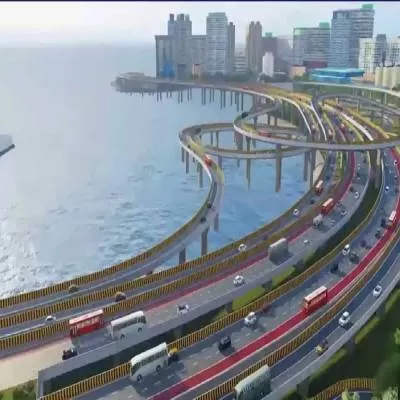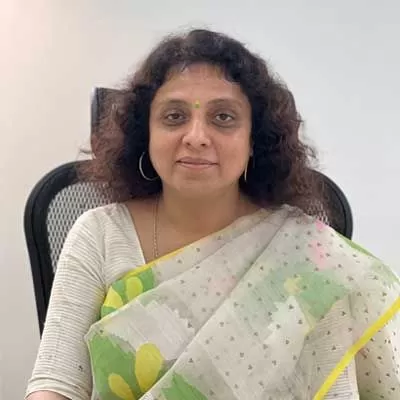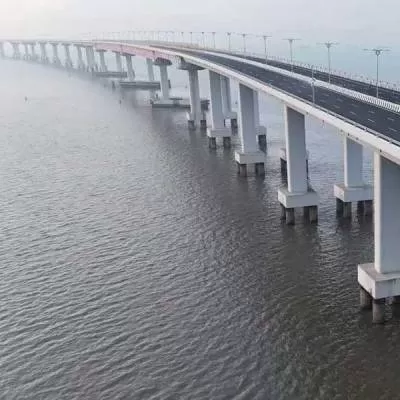- Home
- Infrastructure Transport
- ROADS & HIGHWAYS
- The Nagpur-Mumbai Expressway will reduce travel time between both cities by half

The Nagpur-Mumbai Expressway will reduce travel time between both cities by half
Maharashtra is set to flourish
20 years ahead - the key to success lies in its plan to develop the prosperity corridor, the Nagpur-Mumbai Super-Communication Expressway. This will assure sustainable development and lead to opportunities in employment generation, agricultural growth, robust infrastructure and reverse migration. Spearheading this project is the Maharashtra State Road Development Corporation (MSRDC), which recently invited request for qualification (RFQ) for 16 packages on the EPC mode from global construction majors. Elaborating on opportunities along the expressway project, popularly known as the Maharashtra Samruddhi Corridor (MSC), Kiran V Kurundkar, Joint Managing Director, MSRDC, reveals that the joint measurement survey along the 702-km stretch is on currently. ´While the survey in most parts of Nagpur is under progress, preparations are on to conduct a similar survey in remaining districts.´ He elaborates upon the future opportunities and benefits of this expressway in conversation with SHRIYAL SETHUMADHAVAN.
MSRDC has called for RFQ of 16 packages. What is the response received so far? The response is good. To prepare the detailed project report (DPR), we have divided the complete length into five different packages. This is based on the revenue division-based method, which includes Nagpur, Amravati, Aurangabad, Nashik and Thane. However, to award the contracts, we have further divided this into 16 packages as one company cannot be awarded the complete length. These are all milestone-based activities. Once we complete the RFQ, companies will be shortlisted and we will issue the request for proposal (RFP).
What is the total cost of the civil works involved in these packages?
Of the total project cost of Rs 46,000 crore, MSRDC has indicated that Rs 24,000 crore will be the civil cost, while contingencies, financing charges and IDC will be Rs 6,000 crore. Node development cost is Rs 2,500 crore; utility shifting will cost Rs 500 crore and land acquisition will cost Rs 13,000 crore. The project is expected to be completed by October 2019.
The project is based on a unique partnership model: The land-pooling method..
Land pooling has been a successful model undertaken by the Andhra Pradesh Government recently. Here, farmers will first get 25 per cent of the surrendered land as developed land. It will be in the form of nodes, which will be developed at every 40 km stretch of the expressway. The farmers will be getting an annuity for the next 10 years to compensate for the loss of crops and will also be given skill development training. The developed land can be sold later by the farmers at the price they wish. The government can also buy the land from the farmers, where it will pay the farmer the rates of the land pooling activity with 9 per cent per annum rate of interest.
What benefits will MSC bring to the surrounding infrastructure?
The main objective is to provide faster connectivity to JNPT, which is a major port. Ten districts are being covered and they will be on a faster connectivity corridor that will facilitate faster transportation of goods as well as traffic.
It will reduce travel time between Nagpur and Mumbai by half because, at present, the container traffic or whatever goods are transported from Nagpur to JNPT or Mumbai takes more than sixteen hours.
So that will be reduced to half.
The expressway will go a long way in ensuring better efficiency for transporters and lower transportation costs. Being a greenfield project, it will have a new alignment. MSC will also have 23 new towns with truck terminuses, commercial sites, knowledge city, IT parks, manufacturing units, schools, educational institutions, hospitals, parks, etc. The eight-lane expressway envisages complete digital connectivity with optical fibre network along the entire route. CCTV cameras and state-of-the-art facilities such as WiFi will also be installed along the stretch. MSC will also boost agro-based industries and attract globally competitive manufacturing units in Vidarbha and Marathwada.
In this project, 400 acre is forest land. How do you plan to acquire this? And, what is the environment clearance status on the same?
Forest clearances are required, and we have approached the forest authorities to grant us permission to acquire forest land. By June, we should be in a comfortable position to secure all clearances. The forest authority has its own set of rules and procedures to offer clearance; we have to give equivalent amount of land from the government´s land bank as compensation. At present, we have identified the land parcels and the transfer proposals are being processed.
How is MSRDC planning to fund its road projects, apart from MSC? Do we see infra bonds from MSRDC in the near future?
MSRDC is raising funds from the open market. For MSC, we have appointed SBI Caps as our finance arranger, and have already approached the banks, who have shown keen interest in funding. The corporation may consider bonds at a later stage but, at this stage, it is plain project finance through banks. Besides this, Asian Development Bank has shown keen interest, but we will think of taking finance at a later stage.
Is there any message you would like to share with the industry?
Projects of this scale require contractors who provide earthmoving machinery. Although contractors and the companies engaged in the construction of this expressway will have their own equipment bank, they will have to employ labour and machinery from local areas.
So there is a big opportunity to bring in earthmoving and transportation equipment.
Also, this expressway is going to be made of rigid pavement - a cement concrete road - for which a lot of ready-mix concrete (RMC) will be required.
So, all 16 packages will require 16 RMC plants. By June, we should be able to award contracts for all the packages. Then, whatever pre-monsoon activity can take place will be done, but the actual groundbreaking will be post-monsoon in October.
To share your views on this interview, write in at feedback@ConstructionWorld.in
- Kiran V Kurundkar, Joint Managing Director, Maharashtra State Road Development Corporation (MSRDC) Maharashtra is set to flourish 20 years ahead - the key to success lies in its plan to develop the prosperity corridor, the Nagpur-Mumbai Super-Communication Expressway. This will assure sustainable development and lead to opportunities in employment generation, agricultural growth, robust infrastructure and reverse migration. Spearheading this project is the Maharashtra State Road Development Corporation (MSRDC), which recently invited request for qualification (RFQ) for 16 packages on the EPC mode from global construction majors. Elaborating on opportunities along the expressway project, popularly known as the Maharashtra Samruddhi Corridor (MSC), Kiran V Kurundkar, Joint Managing Director, MSRDC, reveals that the joint measurement survey along the 702-km stretch is on currently. ´While the survey in most parts of Nagpur is under progress, preparations are on to conduct a similar survey in remaining districts.´ He elaborates upon the future opportunities and benefits of this expressway in conversation with SHRIYAL SETHUMADHAVAN. MSRDC has called for RFQ of 16 packages. What is the response received so far? The response is good. To prepare the detailed project report (DPR), we have divided the complete length into five different packages. This is based on the revenue division-based method, which includes Nagpur, Amravati, Aurangabad, Nashik and Thane. However, to award the contracts, we have further divided this into 16 packages as one company cannot be awarded the complete length. These are all milestone-based activities. Once we complete the RFQ, companies will be shortlisted and we will issue the request for proposal (RFP). What is the total cost of the civil works involved in these packages? Of the total project cost of Rs 46,000 crore, MSRDC has indicated that Rs 24,000 crore will be the civil cost, while contingencies, financing charges and IDC will be Rs 6,000 crore. Node development cost is Rs 2,500 crore; utility shifting will cost Rs 500 crore and land acquisition will cost Rs 13,000 crore. The project is expected to be completed by October 2019. The project is based on a unique partnership model: The land-pooling method.. Land pooling has been a successful model undertaken by the Andhra Pradesh Government recently. Here, farmers will first get 25 per cent of the surrendered land as developed land. It will be in the form of nodes, which will be developed at every 40 km stretch of the expressway. The farmers will be getting an annuity for the next 10 years to compensate for the loss of crops and will also be given skill development training. The developed land can be sold later by the farmers at the price they wish. The government can also buy the land from the farmers, where it will pay the farmer the rates of the land pooling activity with 9 per cent per annum rate of interest. What benefits will MSC bring to the surrounding infrastructure? The main objective is to provide faster connectivity to JNPT, which is a major port. Ten districts are being covered and they will be on a faster connectivity corridor that will facilitate faster transportation of goods as well as traffic. It will reduce travel time between Nagpur and Mumbai by half because, at present, the container traffic or whatever goods are transported from Nagpur to JNPT or Mumbai takes more than sixteen hours. So that will be reduced to half. The expressway will go a long way in ensuring better efficiency for transporters and lower transportation costs. Being a greenfield project, it will have a new alignment. MSC will also have 23 new towns with truck terminuses, commercial sites, knowledge city, IT parks, manufacturing units, schools, educational institutions, hospitals, parks, etc. The eight-lane expressway envisages complete digital connectivity with optical fibre network along the entire route. CCTV cameras and state-of-the-art facilities such as WiFi will also be installed along the stretch. MSC will also boost agro-based industries and attract globally competitive manufacturing units in Vidarbha and Marathwada. In this project, 400 acre is forest land. How do you plan to acquire this? And, what is the environment clearance status on the same? Forest clearances are required, and we have approached the forest authorities to grant us permission to acquire forest land. By June, we should be in a comfortable position to secure all clearances. The forest authority has its own set of rules and procedures to offer clearance; we have to give equivalent amount of land from the government´s land bank as compensation. At present, we have identified the land parcels and the transfer proposals are being processed. How is MSRDC planning to fund its road projects, apart from MSC? Do we see infra bonds from MSRDC in the near future? MSRDC is raising funds from the open market. For MSC, we have appointed SBI Caps as our finance arranger, and have already approached the banks, who have shown keen interest in funding. The corporation may consider bonds at a later stage but, at this stage, it is plain project finance through banks. Besides this, Asian Development Bank has shown keen interest, but we will think of taking finance at a later stage. Is there any message you would like to share with the industry? Projects of this scale require contractors who provide earthmoving machinery. Although contractors and the companies engaged in the construction of this expressway will have their own equipment bank, they will have to employ labour and machinery from local areas. So there is a big opportunity to bring in earthmoving and transportation equipment. Also, this expressway is going to be made of rigid pavement - a cement concrete road - for which a lot of ready-mix concrete (RMC) will be required. So, all 16 packages will require 16 RMC plants. By June, we should be able to award contracts for all the packages. Then, whatever pre-monsoon activity can take place will be done, but the actual groundbreaking will be post-monsoon in October. To share your views on this interview, write in at feedback@ConstructionWorld.in




















